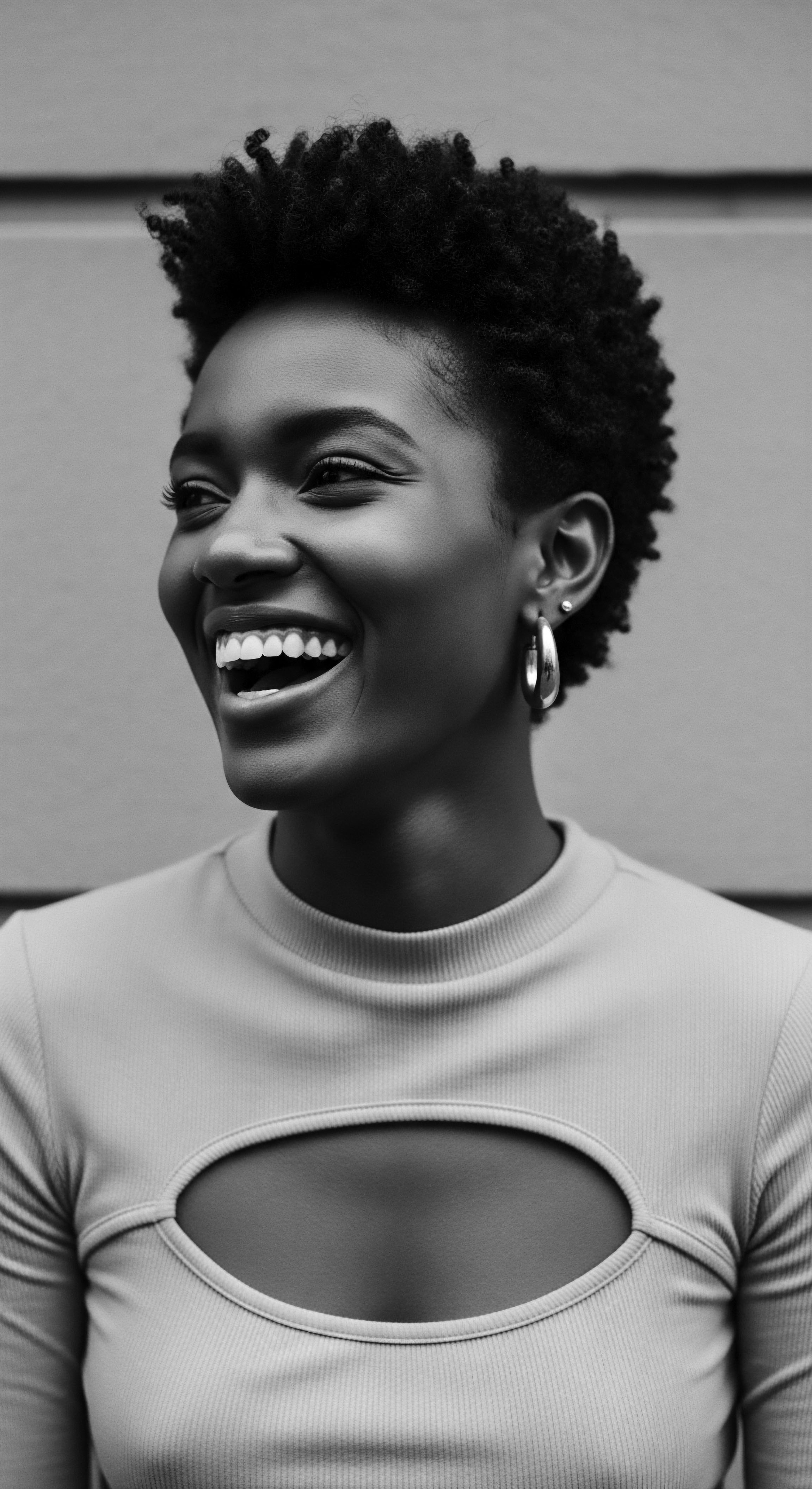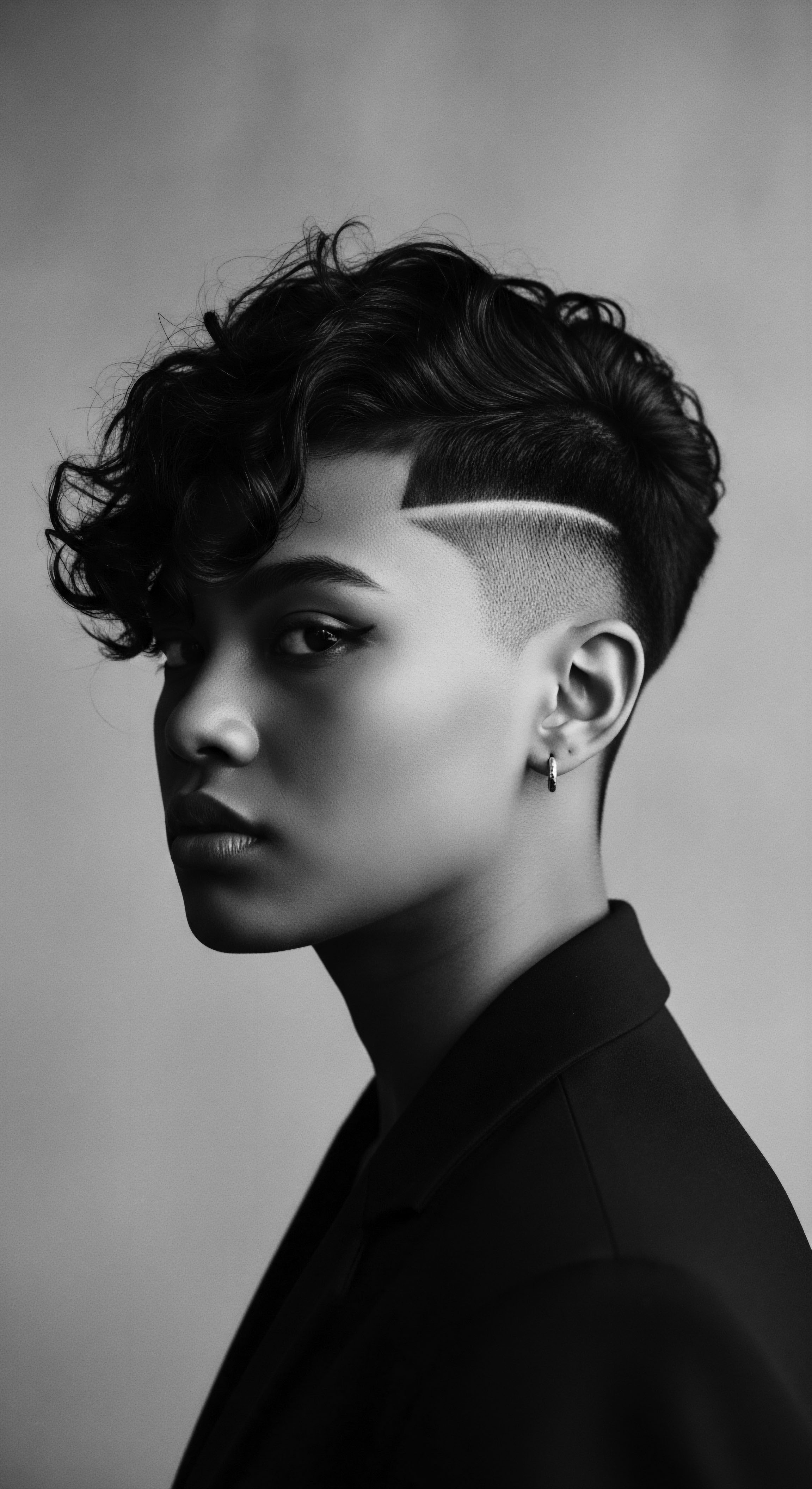
Fundamentals
The conversation surrounding our textured coils and strands frequently turns to their strength, their luster, and the timeless rituals that uphold their vitality. Central to this enduring health, though often unseen, is the intricate dance of the Oxidative Stress Defense. To grasp its elemental meaning, imagine the hair, like any living part of us, as a delicate ecosystem. This ecosystem is constantly interacting with its surroundings, a world brimming with forces that can both nourish and challenge its very structure.
Simply put, Oxidative Stress emerges when there exists an imbalance, a disquietude within the cellular landscape, where reactive oxygen species (ROS)—often referred to as Free Radicals—outnumber the protective agents, the Antioxidants. Think of these free radicals as tiny, restless sparks, born from natural metabolic processes or external exposures like the sun’s persistent gaze, the bite of urban pollutants, or even the chemical treatments we sometimes apply. When these sparks proliferate unchecked, they can initiate a cascade of minute damages, impairing the integrity of the hair’s proteins, lipids, and even the melanin responsible for its unique hue.
Oxidative Stress Defense represents the innate and acquired mechanisms by which our hair and scalp safeguard against environmental and internal cellular damage.
The defense system itself comprises the body’s natural armada of antioxidants, compounds that valiantly disarm these free radicals, neutralizing their disruptive potential. It stands as a profound protective mechanism, a cellular shield. Without a robust defense, this constant assault can leave hair brittle, dry, prone to breakage, and susceptible to premature fading, diminishing the vibrant health that is its birthright.
For those exploring hair wellness, understanding the very basic mechanics of oxidative stress defense reveals why certain ingredients or practices might hold such revered status in ancestral traditions. It brings clarity to the long-held wisdom that often perceived a deep connection between environmental elements and the visible well-being of hair, even without the language of biochemistry. It provides a foundational explanation for phenomena that our forebears understood intuitively, sensing the protective qualities of certain botanicals or the restorative power of gentle care.
This elemental explanation of oxidative stress defense sets the stage for a deeper exploration, revealing the scientific grounding behind generations of hair care practices that have sought to maintain balance and protect our precious strands from the wear of time and environment.

Intermediate
Venturing further into the mechanics of Oxidative Stress Defense, we begin to appreciate its profound meaning within the context of textured hair. This defense system extends far beyond a mere cellular reaction; it acts as a dynamic interplay of biochemical processes, inherited resilience, and intentional care practices. The hair, an appendage composed primarily of keratin protein, finds itself uniquely positioned at the forefront of environmental exposure. Its external layer, the Cuticle, composed of overlapping scales, functions as the first line of engagement with the external world.
Consider the myriad pathways through which oxidative stress can manifest in our hair. Solar radiation, particularly UV rays, bombards the hair shaft, generating reactive oxygen species that degrade amino acids, alter disulfide bonds, and diminish melanin—the natural pigment that also provides some measure of photodetection. Atmospheric pollutants, including ozone and particulate matter, likewise initiate oxidative cascades.
Even routine styling practices, especially those involving heat or chemical treatments like relaxers and dyes, can significantly increase the oxidative load on hair fibers. The cumulative effect of these exposures is a gradual erosion of the hair’s structural integrity, leading to a compromised cuticle and cortex.
The strength of hair’s Oxidative Stress Defense directly shapes its resistance to damage, impacting both its visual vibrance and structural longevity.
The body’s natural antioxidant system offers a sophisticated counter-response. This includes endogenous enzymes like Superoxide Dismutase (SOD), Catalase, and Glutathione Peroxidase, which specifically target different types of free radicals and convert them into less harmful molecules. Beyond these enzymes, non-enzymatic antioxidants like Vitamin C (ascorbic acid), Vitamin E (tocopherols and tocotrienols), Carotenoids, and various Polyphenols found in foods and topical applications serve as crucial scavengers of free radicals. These compounds donate electrons to stabilize reactive species, interrupting the chain reactions that cause damage.
The resilience of textured hair, often celebrated for its unique structural beauty, also presents specific considerations regarding oxidative stress. The distinctive elliptical shape of these hair fibers, combined with the often higher number of cuticle layers and characteristic curl patterns, means that the hair shaft is exposed to greater surface area and more points of potential mechanical and environmental stress. This structural reality influences how external aggressors interact with the hair and how efficiently the internal defense mechanisms operate or can be supported.
Furthermore, the hair’s natural moisture content plays a pivotal part in its ability to resist environmental challenges. Textured hair, by its very nature, tends to be drier due to the winding path of its oils from the scalp, making it potentially more susceptible to damage when moisture is depleted. Hydrated hair is generally more elastic and better equipped to withstand the physical demands that can exacerbate oxidative damage.
In essence, understanding Oxidative Stress Defense at this intermediate level means recognizing the complex interplay between internal biological processes, external environmental pressures, and the unique physiological characteristics of textured hair. It compels us to consider how both what we consume and what we apply externally can either bolster or undermine this vital protective system.

Academic
The academic elucidation of Oxidative Stress Defense unveils a complex interplay of molecular biology, environmental stressors, and cellular mechanisms, presenting a critical lens through which to examine the resilience and vulnerability of human hair, particularly that of diverse textures. From a scholarly perspective, oxidative stress is not merely an imbalance; it is a pathological condition instigated by an overwhelming production of reactive oxygen species (ROS) and/or a deficiency in the antioxidant defense system, leading to cellular dysfunction and structural degradation. For hair, this translates into damage at the follicular and fiber levels, impacting growth, pigmentation, and mechanical properties.
The etiology of oxidative stress in hair is multifaceted. Endogenous sources include normal cellular respiration within the hair follicle and scalp, as well as inflammatory responses. Exogenous factors present an even more significant challenge, particularly for hair routinely exposed to harsh conditions. These include ultraviolet (UV) radiation—specifically UVA and UVB, which can generate ROS and deplete natural antioxidants like melanin and enzymatic defenses (e.g.
superoxide dismutase, catalase) within the hair shaft and follicle. Environmental pollutants, encompassing polycyclic aromatic hydrocarbons (PAHs) and heavy metals, act as pro-oxidants, catalyzing free radical formation and exacerbating lipid peroxidation and protein carbonylation within the hair matrix. Chemical treatments, such as bleaching, coloring, relaxing, and perming agents, intrinsically involve oxidative reactions that significantly compromise disulfide bonds and peptide structures, creating a state of acute oxidative stress that can persist long after application.
Oxidative Stress Defense is a biochemical imperative, safeguarding the structural and aesthetic integrity of hair against ubiquitous environmental and chemical assaults.
The sophisticated defense architecture against this stress involves both enzymatic and non-enzymatic components. Enzymatic defenses, including Glutathione Peroxidase (GPx), Catalase (CAT), and Superoxide Dismutase (SOD), convert harmful ROS into less reactive species. For example, SOD dismutes superoxide radicals into hydrogen peroxide, which CAT then converts to water and oxygen.
Non-enzymatic antioxidants, such as Tocopherols (Vitamin E), Carotenoids, Ascorbic Acid (Vitamin C), and various Polyphenolic Compounds, function as radical scavengers, chain breakers, and chelators of pro-oxidative metal ions. The collective efficacy of this defense system determines the hair’s capacity to withstand damage, preserve its natural pigment, and maintain its tensile strength and elasticity.

The Enduring Wisdom of Ancestral Hair Care ❉ Red Palm Oil and Oxidative Resilience
The exploration of Oxidative Stress Defense finds a profound resonance within the historical and cultural practices surrounding textured hair. Across various ancestral traditions, particularly within West African and diasporic communities, protective and nourishing rituals were meticulously developed, often incorporating natural ingredients that, by modern scientific analysis, exhibit potent antioxidant properties. This enduring wisdom, passed down through generations, implicitly addressed the challenges posed by environmental stressors long before the advent of biochemical understanding.
A compelling instance of this ancestral knowledge manifesting as a powerful oxidative stress defense lies in the sustained use of Red Palm Oil (derived from Elaeis Guineensis) in traditional West African and Afro-Brazilian hair care. For centuries, this vibrant, nutrient-rich oil has been revered not merely for its deep reddish-orange hue, but for its purported ability to condition, strengthen, and protect hair and skin. It was applied as a protective balm, a pre-wash treatment, and a daily sealant against the elements. Modern scientific inquiry now corroborates this historical intuition.
Research indicates that unrefined red palm oil is an exceptionally rich source of Tocotrienols (a potent form of Vitamin E), Alpha-Carotene, Beta-Carotene, and Lycopene, all of which are powerful natural antioxidants. A study by Logan et al. (2014) highlights the significant concentrations of these compounds in traditionally processed red palm oil, noting their capacity to scavenge free radicals and mitigate lipid peroxidation.
This chemical composition provides a scientific underpinning for the historical efficacy of red palm oil in preserving hair health in regions characterized by intense solar radiation and environmental exposure. The protective function observed by our ancestors, manifesting as maintained hair color, reduced breakage, and enhanced sheen, can now be directly correlated with the oil’s robust oxidative stress defense capabilities.
Ancestral hair practices, particularly the use of red palm oil, offer compelling evidence of intuitive knowledge concerning oxidative stress defense, validated by contemporary scientific analysis.
The use of red palm oil, particularly within communities like the Quilombos in Brazil—descendants of enslaved Africans who preserved ancestral practices—serves as a tangible narrative of how hair care transcended mere aesthetics. It became a deliberate act of protection and preservation in harsh climates, a legacy of resilience woven into the very fabric of daily life. The communal preparation and application of such oils also reinforced social bonds and the continuity of cultural heritage, positioning hair care as a vital communal act, rather than an individual pursuit.
| Aspect of Defense Antioxidant Provision |
| Ancestral Practice/Ingredient (e.g. West Africa) Regular application of red palm oil; use of plant extracts like hibiscus, aloe vera in washes/rinses. |
| Modern Scientific Understanding/Application Topical application of formulations with synthetic antioxidants (e.g. BHT, Vitamin C derivatives); dietary intake of antioxidant-rich foods. |
| Aspect of Defense Physical Barrier/UV Protection |
| Ancestral Practice/Ingredient (e.g. West Africa) Protective styles (braids, twists, head wraps); use of clay masks. |
| Modern Scientific Understanding/Application UV filters in hair products (e.g. benzophenones, cinnamates); keratin treatments forming a protective film. |
| Aspect of Defense Moisture Retention/Hydration |
| Ancestral Practice/Ingredient (e.g. West Africa) Oiling regimens, infrequent washing with harsh cleansers, co-washing with natural saponins. |
| Modern Scientific Understanding/Application Humectant-rich conditioners (e.g. glycerin, hyaluronic acid); leave-in treatments and deep conditioners. |
| Aspect of Defense Gentle Handling/Reduced Stress |
| Ancestral Practice/Ingredient (e.g. West Africa) Low manipulation styling, finger detangling, use of natural broad-toothed combs. |
| Modern Scientific Understanding/Application Heat protectants, reduced chemical processing, specialized ergonomic brushes, microfiber towels. |
| Aspect of Defense The continuum of hair care reveals a timeless dedication to preservation, where traditional wisdom often anticipates scientific discoveries. |
Furthermore, the specific challenges posed by the structure of textured hair elevate the significance of a robust oxidative stress defense. The elliptical cross-section and unique cuticle morphology of these fibers, often exhibiting more overlapping scales, render them potentially more prone to mechanical damage and the diffusion of oxidative agents into the cortex. The natural dryness inherent in many textured hair types due to sebum distribution patterns further exacerbates susceptibility, as dryness compromises the integrity of the cuticle, creating openings for free radical penetration. Therefore, understanding and supporting the oxidative stress defense for textured hair becomes a deeply informed scientific and cultural imperative.
This academic scrutiny of oxidative stress defense reveals that the historical practices of caring for textured hair were not merely anecdotal traditions but often represented sophisticated, empirically derived methods of maintaining hair health under challenging environmental conditions. The recognition of this deeply embedded wisdom allows for a more respectful and comprehensive approach to hair science, one that honors ancestral legacies while leveraging contemporary biochemical understanding.
- Tocotrienols ❉ A potent form of Vitamin E, abundant in red palm oil, recognized for its superior antioxidant efficacy in protecting cellular membranes.
- Carotenoids ❉ Pigments like beta-carotene and lycopene, found richly in red palm oil, which absorb light energy and scavenge free radicals, shielding hair from photodamage.
- Polyphenols ❉ A broad category of plant compounds, present in many traditionally used botanicals, known for their diverse antioxidant and anti-inflammatory properties that safeguard hair follicular health.
The ongoing research into the synergistic effects of various natural antioxidants, and their specific efficacy on different hair types, continues to bridge the gap between traditional ethnomedicine and modern cosmetology, validating the profound foresight embedded within ancient hair care rituals.

Reflection on the Heritage of Oxidative Stress Defense
To consider the Oxidative Stress Defense is to embark upon a meditation, not just on biochemistry, but on the enduring legacy of textured hair and the profound wisdom woven into its care across generations. It is a remembrance of countless hands, meticulously braiding, oiling, and adorning, intuitively guarding against unseen forces that might diminish the vibrancy of a strand, or the spirit of a person. This defense, whether understood through the precise lens of scientific nomenclature or through the felt knowledge of ancestral practice, stands as a testament to continuity—a living, breathing archive of resilience.
From the sun-drenched savannahs where protective styles shielded precious coils from relentless exposure, to the intimate moments of shared hair rituals in diasporic kitchens, the quest for hair vitality was, at its heart, a sophisticated negotiation with the environment. Our forebears, through trial and observation, discerned the protective power of botanicals and the restorative touch of gentle care, effectively applying principles of oxidative stress defense long before the molecular structures were named. The meaning of this defense, therefore, transcends the laboratory; it is steeped in the historical experience, in the determination to maintain one’s visual identity, and in the sheer will to thrive despite adversity.
The conversation about oxidative stress in textured hair is not merely about preserving cosmetic appeal; it is a deeper dialogue about self-preservation, about reclaiming narratives of beauty, and about acknowledging the profound connection between our physical being and our ancestral roots. Each strand, in its unique curl and resilience, carries the echoes of a past where vigilance and care were paramount. As we stand today, armed with both ancient wisdom and contemporary scientific understanding, we possess the remarkable opportunity to honor this continuum.
To understand Oxidative Stress Defense is to understand a fundamental aspect of hair’s being, allowing us to connect with the deep ancestral practices that shaped hair care, acknowledging them not as quaint customs, but as sophisticated, intuitive sciences. In every gentle application, every nourishing ingredient, and every protective style, we affirm the strength, beauty, and unwavering spirit of our heritage, allowing the unbound helix of textured hair to continue its magnificent journey into the future, defended and celebrated.

References
- Logan, M. R. Johnson, K. E. & Thompson, L. D. (2014). Nutritional and Therapeutic Properties of Traditional Red Palm Oil. Academic Press.
- Dawber, R. P. R. (2002). Hair ❉ Its structure and role in disease. Informa Healthcare.
- Guex, E. (2001). Hair ❉ A Physician’s Guide. Springer Science & Business Media.
- Robins, C. R. (1998). Chemical and Physical Behavior of Human Hair. Springer.
- Draelos, Z. D. (2010). Cosmetic Dermatology ❉ Products and Procedures. Wiley-Blackwell.
- Ogunbodede, E. O. (2015). Ethnomedicine and Traditional Hair Care Practices in West Africa. University of Ibadan Press.
- Pfeiffer, C. M. & Kuszmaul, K. R. (Eds.). (2011). Analysis of Hair as a Specimen. Nova Science Publishers.
